SYNERGY Sight and Sound:
2004-09
A View
Special by THE NEW TIMES HOLLER!
An Investigative Report on Audio and Visual Interactions
© Amir Bey, 2013
March 7
|
SYNERGY. A mixing of often contrasting elements to arrive at a new composition. What would be the synergy of sight and sound?
One steamy New York City July night in 2004 I saw and heard the diminutive alto saxophonist/composer Saco Yasuma playing as she stood between the robust and dreaded reed players Ras Moshe and Sabir Mateen. Other than enjoying the sound of Free horn players, I thought their visual contrasts were striking.
This led me to imagining how the relationship between sight and sound could be brought together in performance through costumes that accented the movements of musicians, set designs that included mobiles that made sound as they moved or were struck, and finally art created onstage.
|
SYNERGY
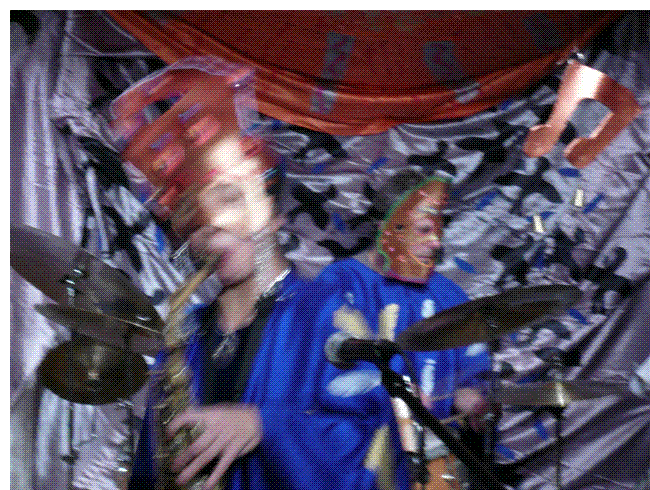
Ras Moshe, reeds; Dave Ross, guitar; Christopher Dean Sullivan, bass; Lou Grassi, drums; Saco Yasuma, reeds, compositions, music director; and Amir Bey, costumes, sets.
Photo Images by (c) Amir Bey, 2009, except where noted.
|
|
TO VIEW VIDEOS OF SYNERGY PERFORMANCES, PLEASE SCROLL DOWN TO THE VIDEO SECTION.
The combination of visual and audio isn't new to "Jazz." Sun Ra and The Art Ensemble of Chicago, are prime originators of recent audio/visual combinations. However, the visual was supportive to the music that those legendary forces played. Being a visual artist deeply inspired by musicians such as the Art Ensemble, my idea was a synergy between sight and sound.
|
THE SYNERGYSTS
| |
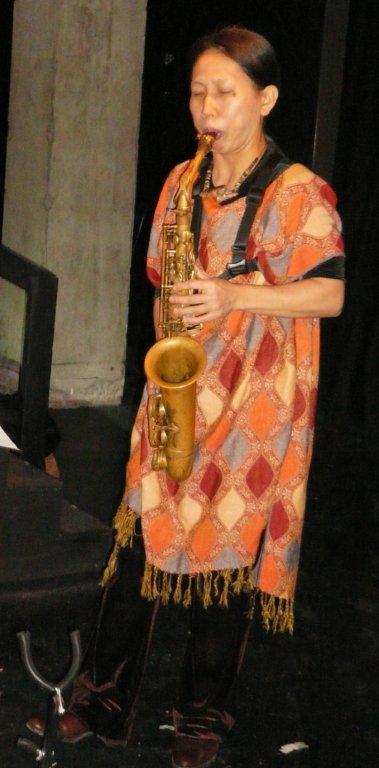
Saco Yasuma
photo by Amir Bey 2009
A Free musician with Asian influences, Saco's compositions and playing are much admired by others. This photo was taken at the Living Theater, where she played with Ken Filiano on bass, and Jason Kao Hwang on violin.
|
|
|
|
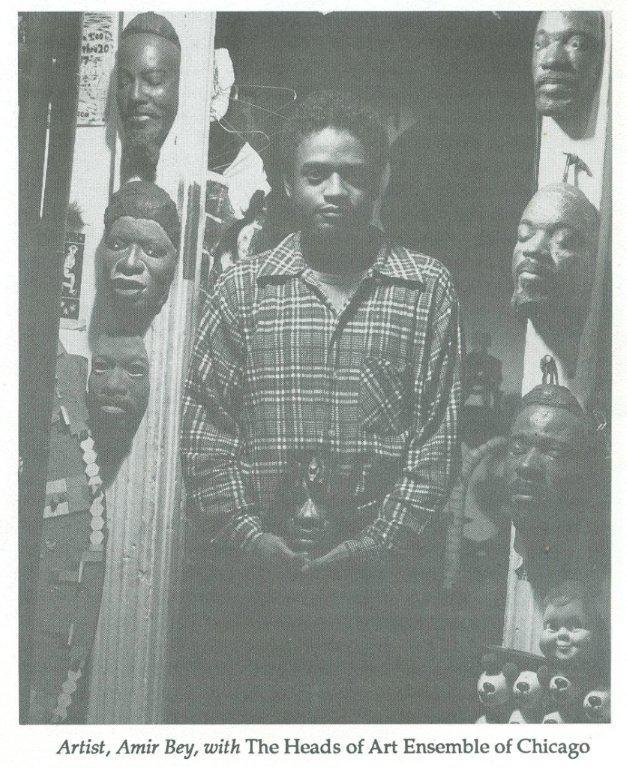
Amir Bey
photo by Gabriel Koren, from Literati Chicago, 1988
The Art Ensemble masks were in progress. Top right, Joseph Jarman, Don Moye, Roscoe Mitchell; Top left, Lester Bowie, Malachai favors, all in bronze; the late painter Ellsworth Ausby in plaster is beneath Malachai. I'm holding a bronze self portrait
|
|
I told Saco how I was moved by the sight of her playing with Sabir and Ras, and I wanted to create costumes and a set, and I asked her if she wanted to collaborate with me. After some discussion we came up with the name SYNERGY Sight And Sound.
Before that steamy night of free jazz - it was a MUSIC NOW! concert, a series now in its 15th year that was organized by Ras Moshe at the old Brecht Forum - I'd shown Saco a long roll of pink chiffon-like fabric that I had silk-screened eyes onto, which I created earlier for a possible performance,but the musician tht I presented it to couldn't use it. When she saw it she said she'd have no problems using it. Now, I silkscreened several long rolls of the same fabric, pink and violet.
She began to think about instrumentation and personnel, deciding on Ras and Sabir on reeds, Francois Grillot on bass, and Jackson Krall on drums. I took their measurements, designed some one-piece flowing tops and took the material to a Senegalese tailor. I thought about doing some face-painting, but Saco reminded me that I could make masks for the musicians.
|
|
|
ONSTAGE AT THE BOWERY POETRY CLUB
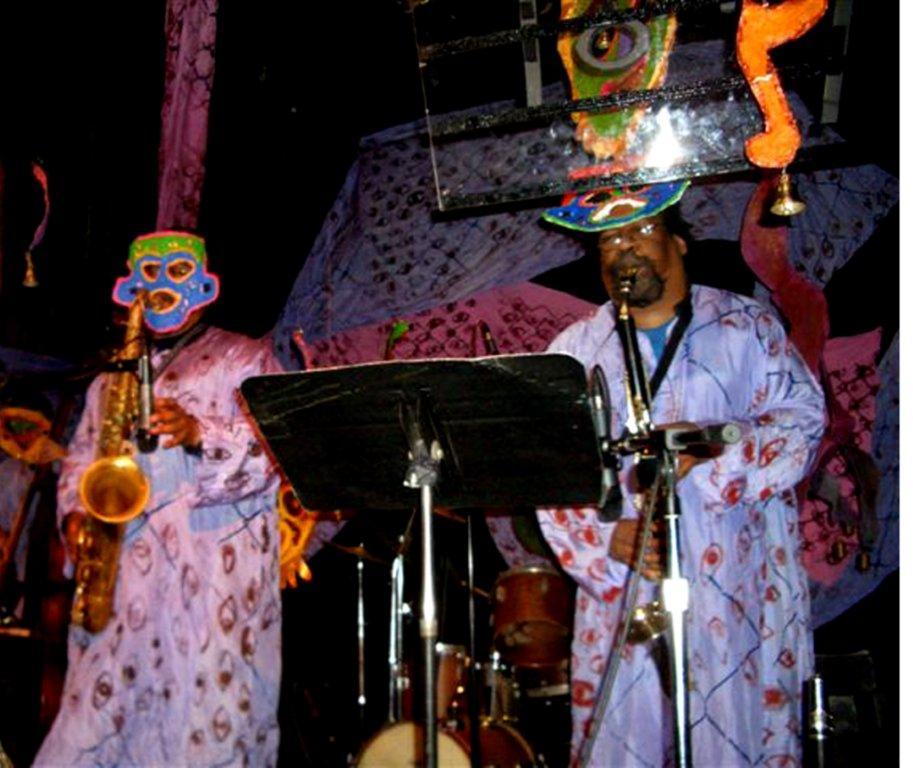
Ras Moshe and Sabir Mateen at our first gig, at The Bowery Poetry Club, October, 2005
|
|
|
LOGO

This logo appeared in our sets, tees, and mobiles, as well as the animated version above.
|
MASKS:
There were a total of 36 made of paper mache, leather, and combinations of paper and fabric in layers.
PAPER MACHE MASKS
| |
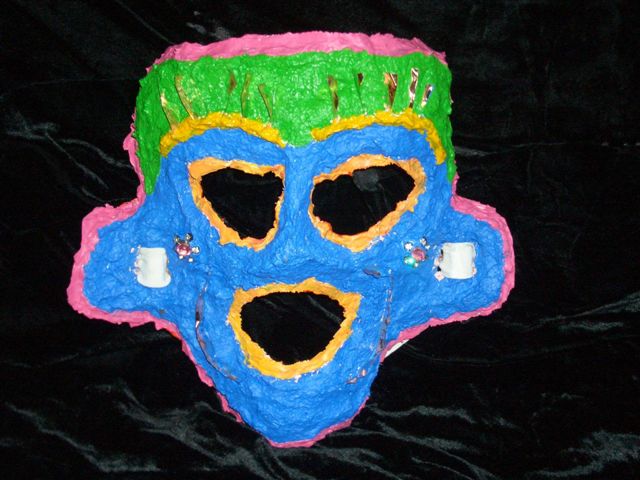
One of Ras Moshe's Masks
Paper Mache, Acrylic, Copper
(c) Amir Bey, 2005; 12"x12"x3"
From the collection of Ras Moshe
|
|
|
|
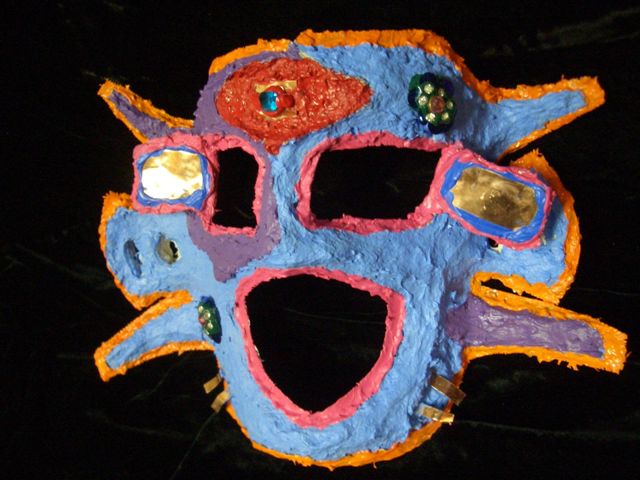
One of Saco Yasuma's Masks
Paper Mache, Acrylic, Rhinestones, Copper
(c) Amir Bey, 13"x12"x4"
|
|
Much of my work deals with the mask and face, but until SYNERGY, only for installations and mounting on walls, stylized carvings or variations of life casts. For performance a mask has to be functional. Its wearer has to be able to see well and feel comfortable. The first Synergy masks I made were paper mache, acrylic,copper, and Rhinestone. While they were beautiful expressions of what I was feeling about Synergy, they were hard, a little heavy, and tight. Unless they really fit, the musicians didn't like them!
|
LEATHER MASKS
| |
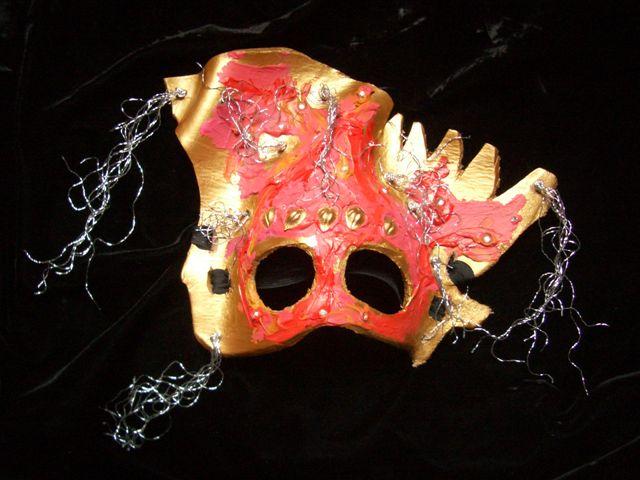
One of Amir's Masks
Leather, Acrylic, Rhinestones, Silver String
(c) Amir Bey, 2007
|
|
|
|
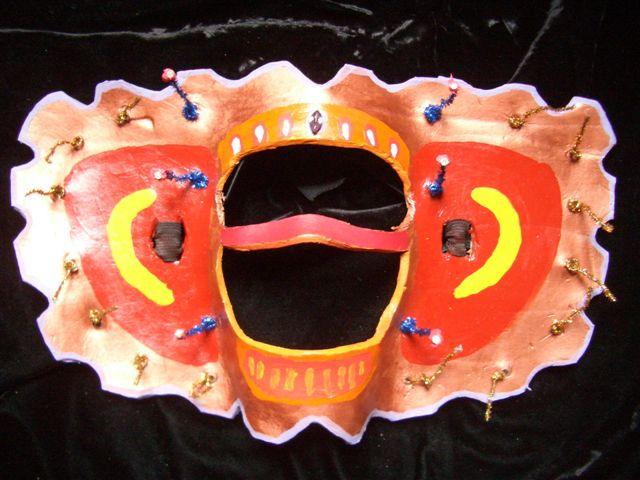
One of the masks worn by Jackson Krall and Dave Ross
Leather, Acrylic, Rhinestones
(c) Amir Bey, 2007
|
|
I began to experiment with raw-hide leather. I shaped the leather by wetting, cutting, texturing, sewing, and using different paints, inks, oils, and waxes. It was more flexible, so there wasn't as much pressure, but there was still some discomfort and heaviness.
|
PAPER AND FABRIC MASKS
| |
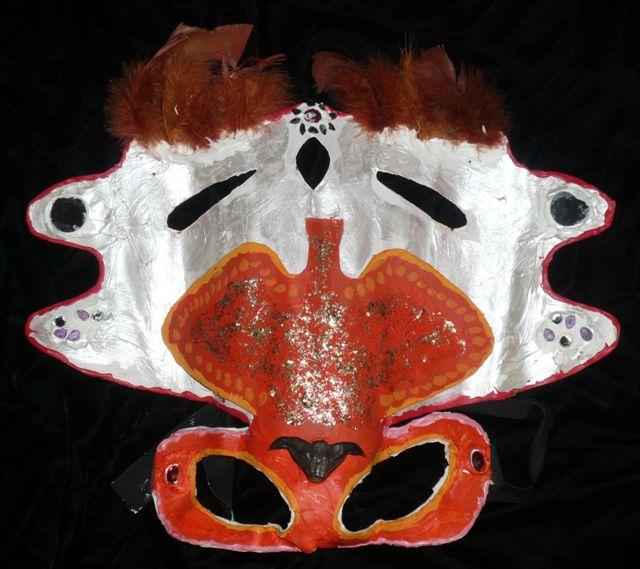
One of Christopher Dean Sullivan's masks
Paper, Fabric, Feathers, Rhinestones, Acrylic, 18"x12"x3"
(c) Amir Bey, 2009
|
|
|
|
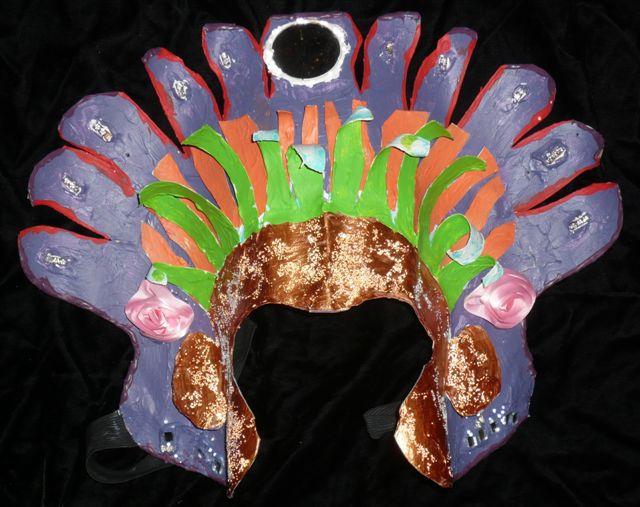
One of Amir's Masks
Paper, Fabric, Rhinestones, Acrylic, 16"13"3"
(c) Amir Bey, 2009
|
|
Several layers of paper and light fabric glued together was strong and was lighter than leather, although more fragile, and didn't hold up to sweat. The layers allowed for different levels of color, feathery touches. If musicians turned or bowed their heads, the mask wouldn't tip or create balance problems.
|
|
|
LEATHER MASKS AND HAND PRINTS
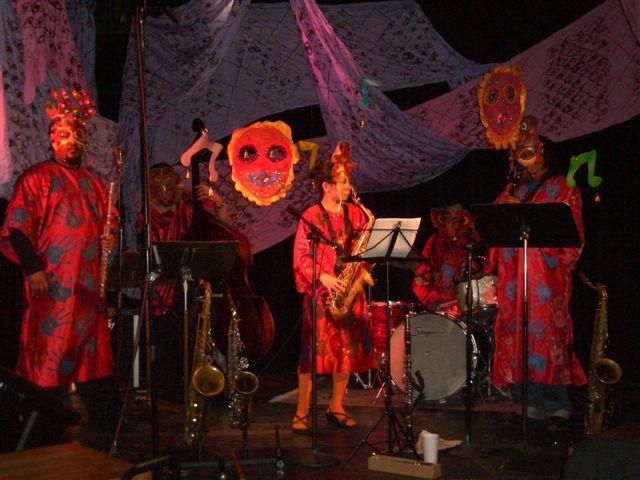
Ras Moshe, Francois Grillot, Saco Yasuma, Jackson Krall, Sabir Matin
|
|
For these costumes instead of silkscreening the fabric, I inked my hands and made differnt patterns for each musician.
|
MUSIC MASKS
There were 9 made
| |
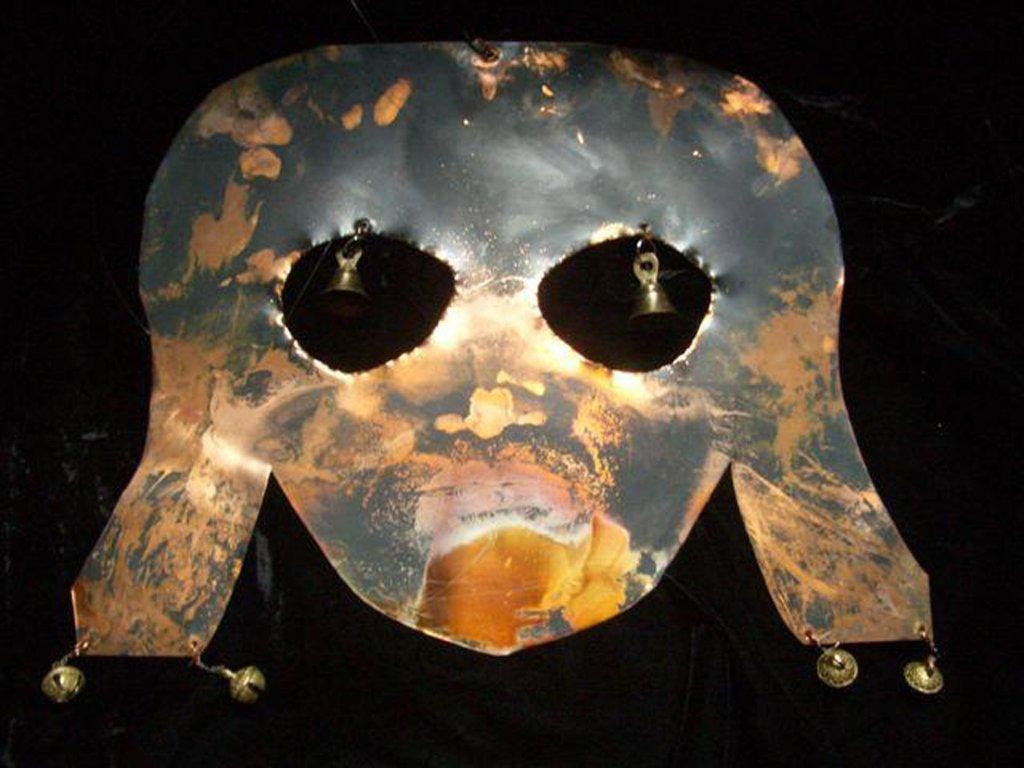
Etched Copper Foil, Brass Bells, 12"x16"x1"
(c) Amir Bey, 2006
|
|
|
|
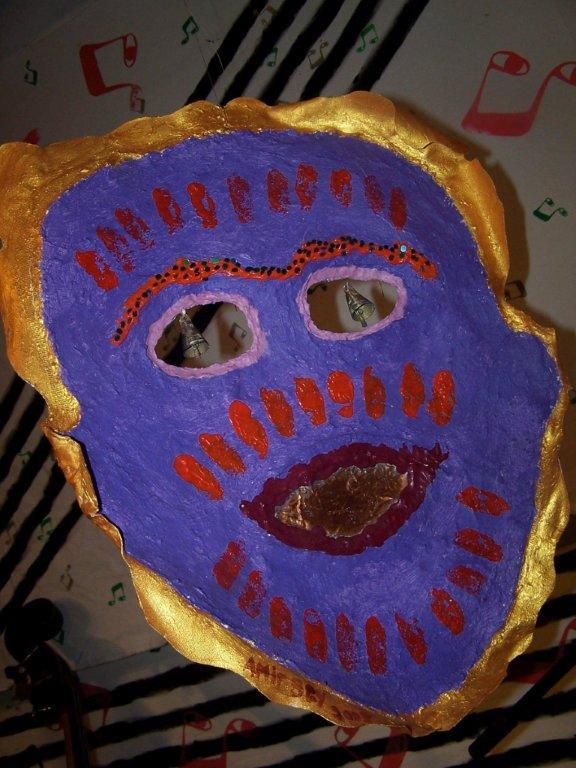
Canvas, Paper Mache, Acrylic, Brass Bells, Copper Foil 2'"18"3"
(c) Amir Bey, 2005
|
|
MUSIC MASKS are mobiles in the form of masks that are suspended by fish chord. They have brass bells attached to them as eyes and other parts of the face. To use them they are shook, spun, or swayed. They can either be all thick copper foil like the one on the left, or larger heavier constructions of canvas, paper mache, acrylic, and of course brass bells that are also larger. The larger MUSIC MASKS have a different mask on the other side, like the MUSIC FAN below.
|
MUSIC NOTES
10 made altogether
Were among the first SYNERGY percussive instruments; there were 10 made. The brass bells were first attached to paper mache, then the more flexible and durable leather.
| |
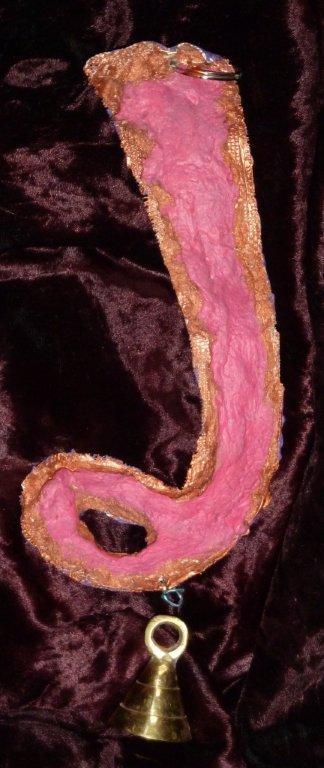
MUSIC NOTE
Paper Mache, Brass Bells, Acrylic; 12"x3"
(c) Amir Bey, 2005
|
|
|
|
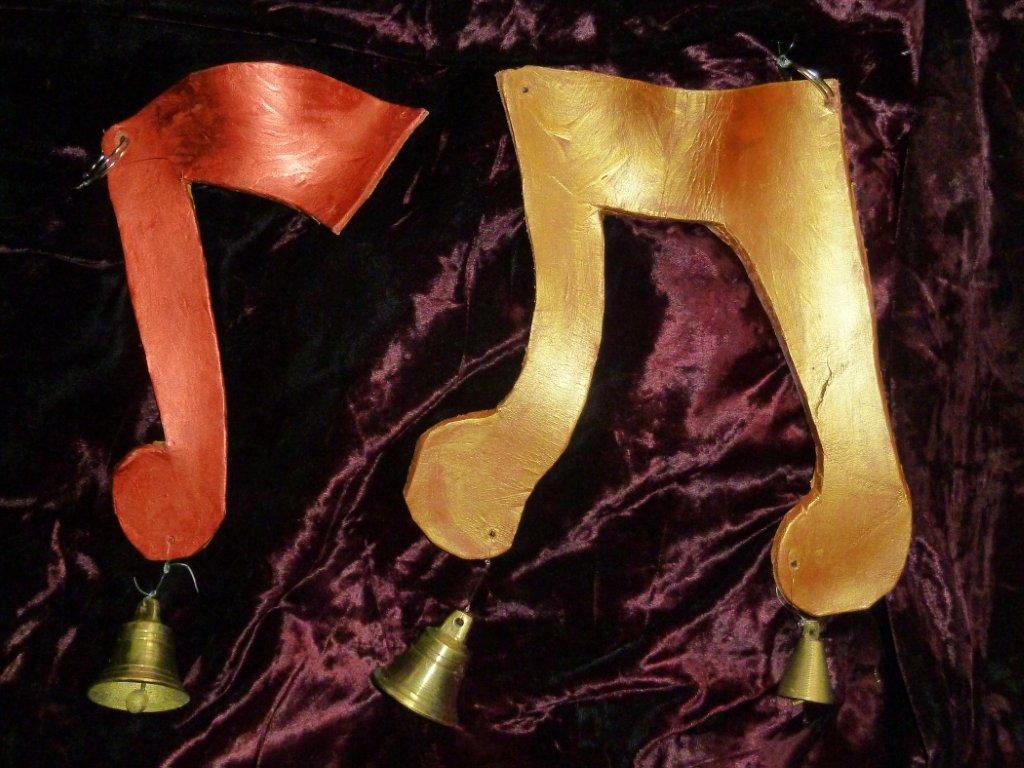
MUSIC NOTES
Leather, Brass Bells, Acrylic; Notes' image dimensions: 12"x16"
(c) Amir Bey, 2006
|
MUSIC FANS
Saco Yasuma's is shown here; 10 were made.
| |
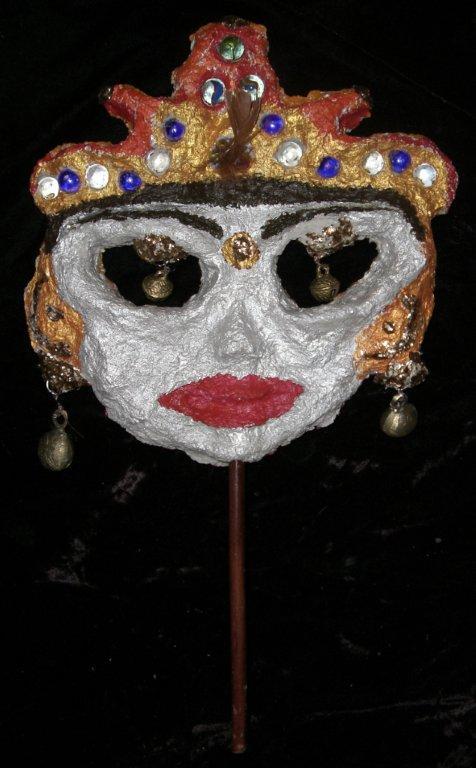
Side A
18"x9"x2"
(c) Amir Bey, 2007
|
|
|
|
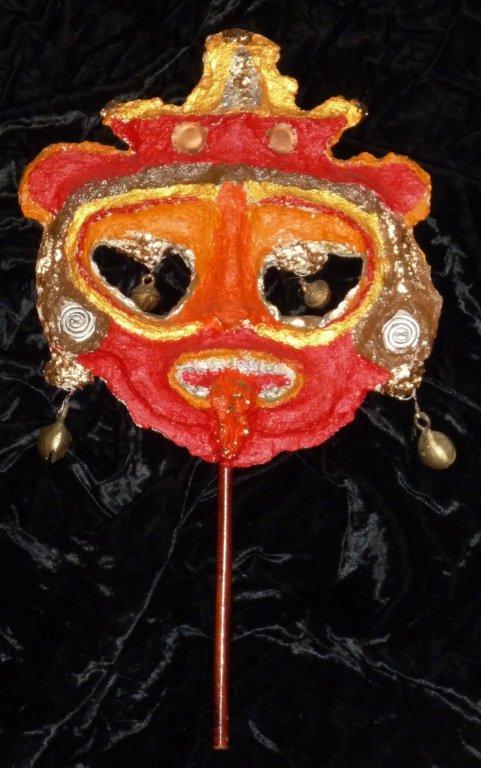
Side B
18"9"2"
(c) Amir Bey, 2007
|
|
MUSIC FANS were hand-held versions of MUSIC MASKS that could have different sides and reversed while playing; these two photos are of the same MUSIC FAN. They could also be used as masks to cover the face. They were made of paper mache, acrylic, brass bells, Rhinestone, marbles, and any reflective materials and paints mounted on wood handles that were sometimes coated with paper mache or thick applications of acrylic. The Music Fans were used in our performance at the 2007 Vision Festival because the Angel Orensanz Foundation's ceilings were too high for the Music Masks.
|
|
|
SYNERGISTIC TRANSFORMATION
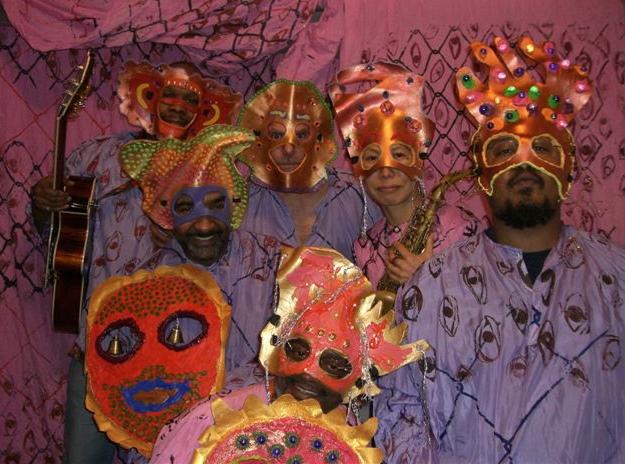
Dave Ross, guitar, Christopher Dean Sullivan, bass, (holding music mask), Lou Grassi, drums, Saco Yasuma, alto saxophone, compositions, Ras Moshe, reeds, Amir Bey, sets, costumes, front
|
COSTUMES
There were four costumes, with several combinations of sets. Only one performance had all the costumes and elements of the sets, at The Black Box; scroll down to see Susan Yung's video further down. These photos are of a wall installation from my exhibit, MASK PARADE held at The Brecht Forum in 2009
| |
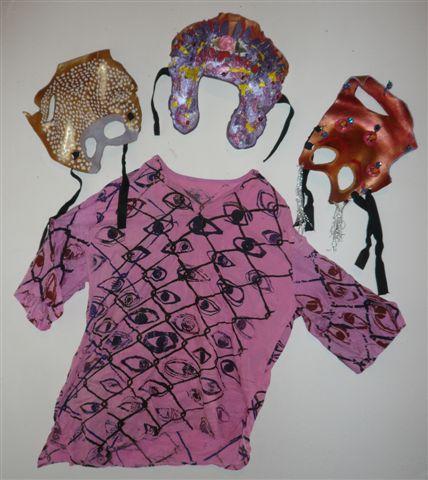
This "Eyes Peering through the Fence" was the first costume
(c) Amir Bey, 2005
|
|
|
|
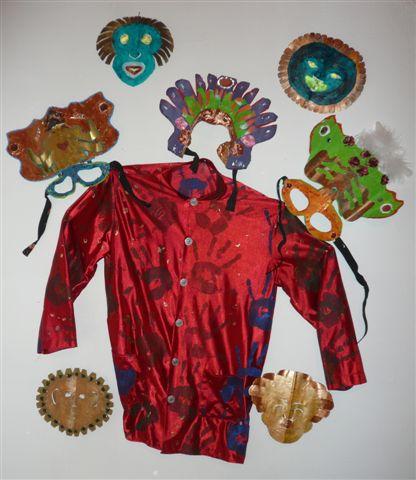
The "Hand" costumes was the second costume
(c) Amir Bey, 2007
|
With these costumes I no longer took my designs to a tailor but sewed them myself.
| |
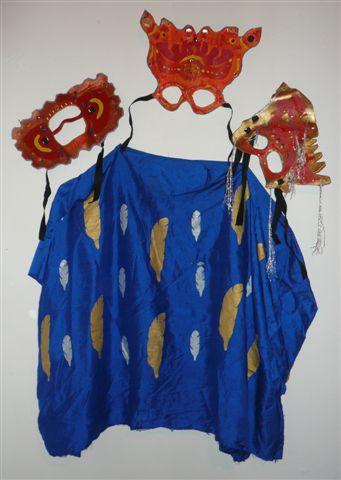
The third costume, a kind of poncho, was silkscreen on Thai Silk, a beautiful fabric to work with! Its feathers motif - Phoenixes to the Sun - inspired by Saco's SKY SUITE, which was performed at the Saint Mark's Church and The Brecht Forum
(c) Amir Bey, 2008
|
|
|
|
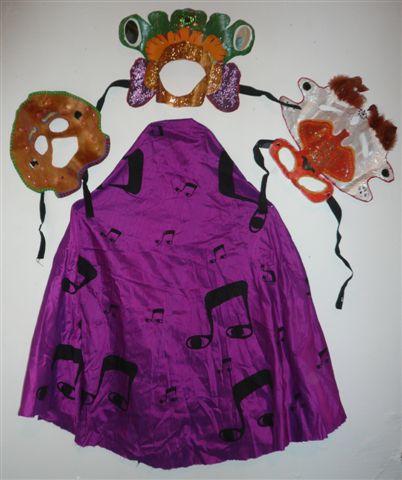
The fourth costume was capes of different colors for each performer. It included our logo

(c) Amir Bey, 2009
|
        
|
3 VIDEOS
By: A-BOP TV, at The Brecht Forum, 2007; ROBERT O'HAIRE (STRAW 2 GOLD Pictures), also at The Brecht Forum, 2008; and SUSAN L. YUNG, at The Black Box, 2009.
|
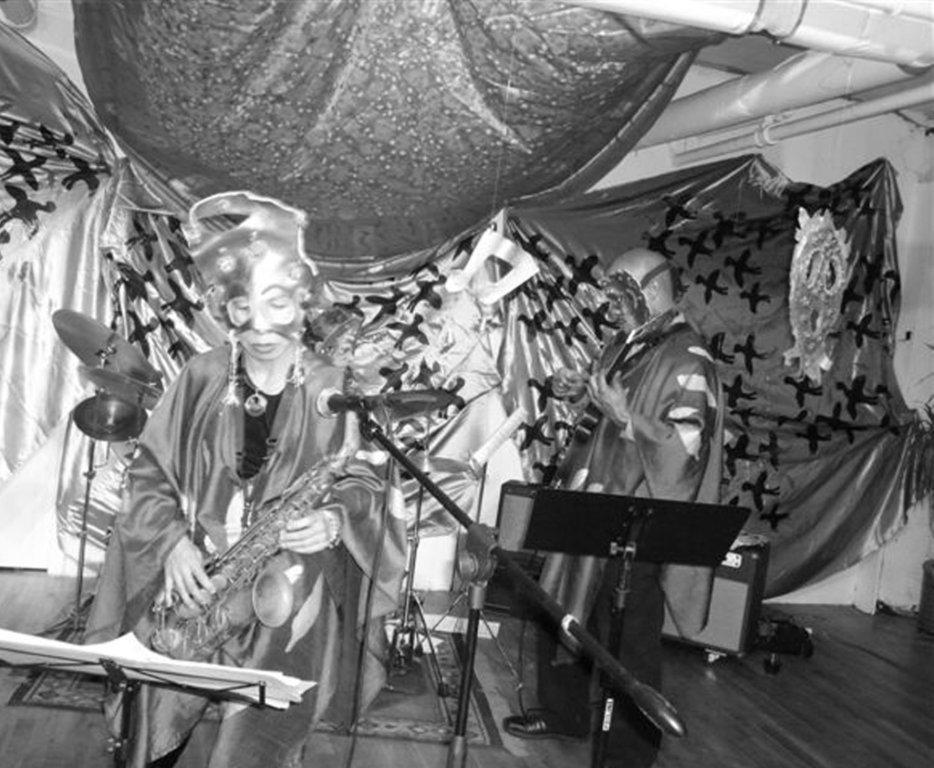
This performance was held on December 29, 2007. For Saco Yasuma's SKY SUITE shown here (18'39"), she composed five tunes, and received a grant from the Manhattan Cultural Council that we wrote for it. Her Sky Suite inspired the feathers on blue Thai Silk costumes, and Phoenixes to the Sun set with the orange sun, and two poems by me. It was first performed at St. Mark's Church,
but the high ceilings there couldn't accommodate our mobiles while The Brecht Forum's did. We also couldn't touch the beautiful walls of the church to install the set, PHOENIXES TO THE SUN
|
|         
A-BOP TV VIDEO
This artistic video is of the tune MIGRATION from Saco Yasuma's SKY SUITE, her tribute to the sky, at The Brecht Forum. It was shot and edited by Albee Balgochian and Jane Grenier using two hand-held cameras, using superb intuition of us and with each other.
|
        

Saco Yasuma, listening in at the Brecht Forum, December 27, 2008.
This generation of "masks" were more like crowns and caps than they were masks. 9'56":
|
|
ROBERT O'HAIRE'S (Straw 2 Gold Pictures) VIDEO
When I printed this backdrop I didn't see it the way that Robert helped me to see it! The tune is Which Came First?, after my poem by the same name, which I recite here.
|
|
|
| |         
|
The Black Box in Harlem was the only performance where we mixed costumes from other performances and changed masks, hats, and crowns for the second set. Please click here to view; 1:06'00":
|
|
~End of Videos~
SYNERGY SIGHT AND SOUND
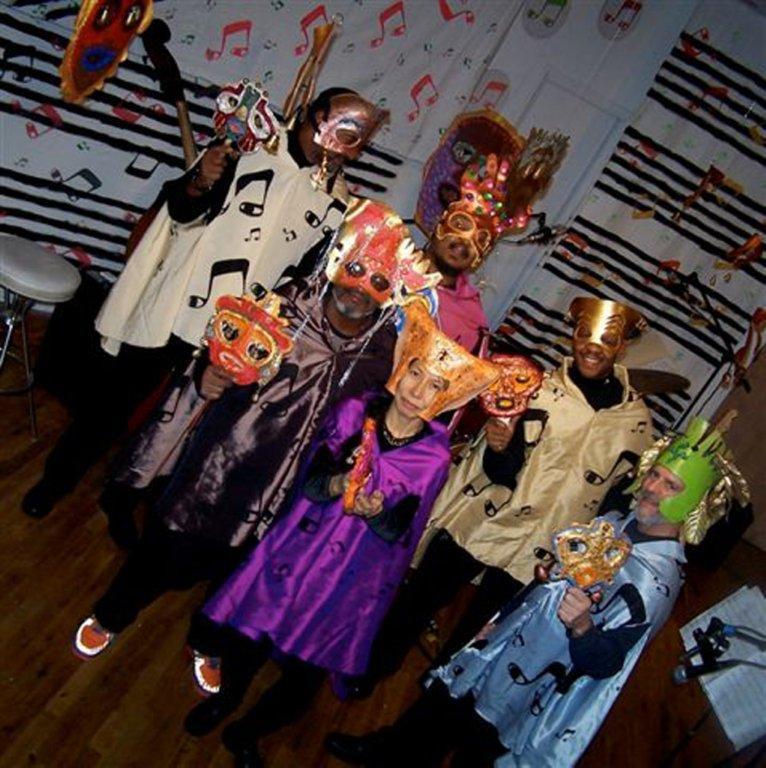
|
|
Christopher Dean Sullivan, bass; Amir Bey, costumes, sets; Ras Moshe, reeds; Saco Yasuma, alto, compositions, music director; Dave Ross, guitar; Lou Grassi, drums.
Photo by Robert O'Haire
|
        
        
        
        
        
        
        
        
|
| | |